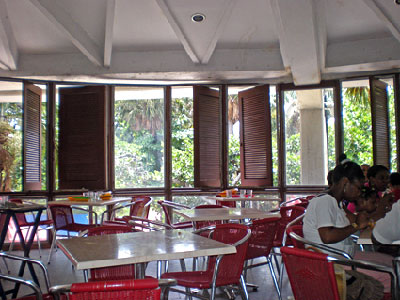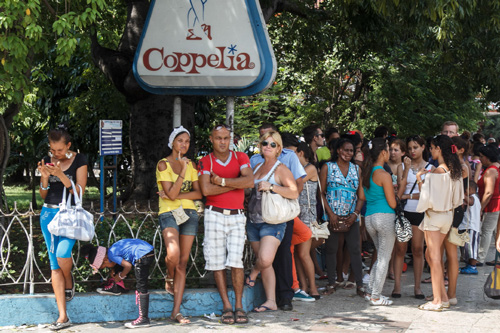Coppelia Ice Cream Parlor in the Eye of Cuban Consumers (I)
Jimmy Roque Martinez and Isbel Diaz Torres

HAVANA TIMES – The Coppelia ice cream parlor is once again a topic for the pages of Havana Times, as the Consumer and Customer Protection project attempts to investigate the numerous problems of this institution and to propose at least one solution.
Coppelia is one of the few locales in Havana where ice cream can be bought at a favorable price in the national currency, and outside of the Nestle monopoly. It’s also – we venture to say – one of very few sites where everyday Cubans can invite their foreign friends.
This popular center serves approximately 12 thousand clients during the week, a figure that can reach 15 thousand on Saturdays and Sundays. The business took in 1 million, 200 thousand pesos (the equivalent of US $60,000) in 2014 according to its director, Antonio Reyes.
The ice cream palace is melting
Nevertheless, Reyes goes on to note that after subtracting expenses for maintenance, landscaping, electricity, water and inputs, a mere 150 thousand pesos ($7,500 US) were left last year. Shared among the 275 workers, this meant an average of 560 pesos ($28) per worker per year. Workers actually receive a monthly salary of barely 235 pesos, less than $12 US.
With so little incentive, this “socialist state enterprise” suffers from very well known problems that we discussed face to face with management.
Pedro Busquet, director of the Recreatur Company, explains that Coppelia has an installed capacity for 680 customers. “As such, we have to maintain a very rapid turn-over so that the clients spend as little time as possible in line.”
In reality, we’ve proven systematically that a great many tables remain empty inside the installation while people wait in long lines on the sidewalks outside the ice cream parlor.
Once seated at the table, customers spend another disproportionate amount of time waiting to be attended and later served.

Busquet stated on Cuban television that: “In the first days of the year, 15 flavors have been offered – mainly chocolate, strawberry, strawberry bonbon, and almond”. He went on to assure us that sufficient raw materials existed to maintain the stability of these flavors.
How can we understand it, then, that the customers don’t encounter any such exotic variety? One flavor only, or, with great luck, two, is what is generally found.
Jorge Barres, another of the establishment’s functionaries, offered his response. “We lack the necessary technical conditions to be able to offer more than three flavors. When you take a lot of time scooping a third or fourth flavor, the ice cream begins to mature and comes out runny,” he explains.
Recreatur’s director had also noted this deficiency, which he catalogued as “an objective difficulty of the serving area”.
Even when the industry has provided us with fifteen flavors in a month, there are days in which we can fluctuate between 7, 8, or 9 flavors, Busquet had stated at the beginning of the year. He added: “In our plan for 2015, we have programmed the importation of an element that totally guarantees an appropriate cold chain in the installation.
Apparently, this promise, made at the beginning of the year, has yet to be realized, given that we’re now in the month of July and the situation continues unchanged.
To this, we would add that even when they have several flavors in stock, a new one isn’t offered until the first flavor runs out, causing additional annoyance among the clientele.
The devil is in the details
The ice cream is currently offered in plastic dishes that appear unhygienic. José Luis Rosales, assistant director of quality assurance, assures us that the dishes have been certified by the city’s health authorities.
What’s certain is that self-employed vendors are not allowed to offer their products in plastic recipients, since these are more difficult to properly clean. For this reason, they are required to use glass cups and ceramic plates.
Many of us remember the old days in Coppelia when the ice cream combinations were served in glass cups or in stainless steel ice cream boats. The type of recipient varied according to the specialty item being served; in addition, these dishes were guaranteed to be hygienic.
Rosales explains that for the moment there are no plans to change the plastic dishes. He assures us that it’s not a question of the budget, but of the fact that “there isn’t enough production in the national industry to back us up.”

In other concerns regarding the ice cream parlor: when the client enters, they are shown to one of the four-person tables. If there are only one, two or three people in the party, the empty seats at the table are then habitually filled with other, unfamiliar people.
In this way, people find themselves forced to listen to others’ conversations, or have others listen in on their conversations, totally violating everyone’s privacy.
According to the Coppelia managent, this is optional. The customers can sit with only the person or people that accompanied them; one person alone can even take up a whole table.
In the interview, they explained that the tables are filled with other, outside people to help speed up the line, but this is contradictory when there are other tables around that are totally empty.
As an example of the consumers’ lack or protection, there’s no information visible regarding this policy. How could a customer, already accustomed to bad service at establishments, find out about the possibility of not having strangers imposed on them, if they are not informed of the option?
There are many more deficiencies in this distinguished establishment, many of them very well known to the readers, but which the administration insists on not recognizing. The second part of this report will speak of the not at all self-critical posture of the Coppelia managers and a solution that the Consumer and Customer Protection collective wishes to propose.






The Moscow subway was indeed built using slave labour. Not everybody who worked on it was a slave, but many who did the harder work were and thousands died in those halls. Moreover, there were hundreds of thousands of slaves in Stalin’s gulag, toiling in mines to dig the iron & coal, hewing the wood & quarrying the stone necessary for the construction of the Moscow subway.
Your friend James Dolsen was perhaps not telling you the most accurate tale of his adventures in China & the USSR. From his obituary:
“Shortly after starting at the Daily Worker, in 1926, he was sent to China to cover what he would later describe as “provincial warlords and their imperialist masters.” He stayed in China until 1931, and the book he wrote there – Awakening China – was the first by an American communist in China.
Returning home on the Trans-Siberian Railway, he stopped in Moscow, where he then stayed four years with International Red Aid. His foreign work ended in the mid-1930s, and he was asked to cover international labor defense work in Pittsburgh, a hotbed of labor unrest.”
Do you really believe a man who admired Mao & Stalin was capable of seeing and telling the truth about those two mass murderers? Yes, Mr Dolsen was a volunteer, just like the many useful idiots who traveled to Cuba to harvest sugar cane in the late 1960’s. But that does not mean there were no slaves digging in the Moscow subway. Likewise, there were slaves & prisoners cutting sugarcane in Cuba, just not in the same field where that gullible young socialist from Vermont was playing at revolutionary summer camp.
Yet another inaccurate assertion. My late friend James Dolsen (1883-1986) was one of the many volunteers who labored in the construction of the Moscow subway during the 1920’s and 1930’s, and had many interesting first hand stories of Moscow–and China–during those years.. Incidentally, although not interviewed for the documentary sections of the 1980’s bio-pic, “Reds,” he was present at several of the scenes depicted in the film.
Also, while the variety of Copelia’s flavors have decreased from its 1960’s through 1980’s heydays, nevertheless, the few remaining flavors are above “supermarket quality.” They are comparable to the delectable home-make ice cream my grandfather churned out on the farm.
I had ice cream cones there 3 years ago, they charged me $1.00 per cone!!
Ice cream is not a core industry, nor will it make very many wealthy. Time to cut it free.
I’ve had Coppellia’s ice-cream. Far from “excellent”, it’s average supermarket quality at best, rather low in flavour.
Moscow’s subway system was built by slave labour at the cost of thousands of lives.
Welcome to socialism and a centrally planned economy. Coppelia’s management has found that they are competing for resources which are either limited or compete with other types of businesses being run by the government bureaucracy. No for profit business would stand for this and would simply go out of business. I remember going to Coppelia one hot afternoon and there were very few flavors available. In the pre-Revolution days you could get delicious tropical flavors like mango and mamey. Hopefully, free enterprise and a more robust economy will eventually take a hold. In the meantime, suck it up. Vanilla or chocolate anyone?
In our city, the Coppelia is large and in a prominent location, but the comparatively high prices lead to people purchasing from private vendors selling ice cream cones from the front of their houses. I have never seen a line-up at the Coppelia. One of the concerns is whether Coppelia and the private vendors boil their water. The water supply is dubious and we boil then chill all ours. The leaking water system is evident across the city with rivulets running down the pot-holed streets.
Let’s not forget agriculture Griffin. That’s the big disaster and again, it’s the system that’s broke! I would love for the powers that are running the show to refrain from blaming the embargo so as I’ve stated many times get that out of the way and stop the BS! Regarding the ice creme, it apparently is excellent. Remember Russia had great subways and ice creme for the masses back a few years ago. Another marxist repertoire that fell apart. i won’t even touch Venezuela, no embargo, largest oil reserves in the world and fallen apart at the seams.
Thanks for your comment but ruined a perfectly good day for me!! 🙂
It is astounding that the Cuban government can’t even run an ice cream shop properly. How could anybody expect them to be able to run an entire country?